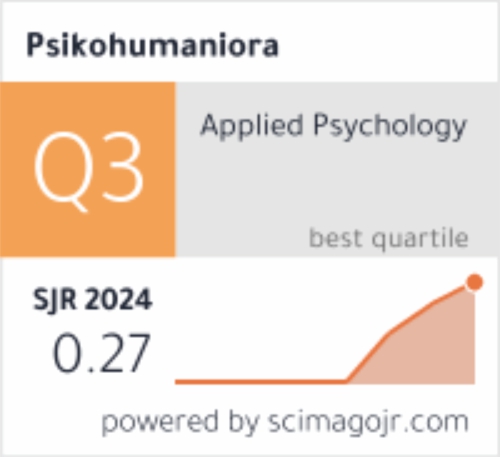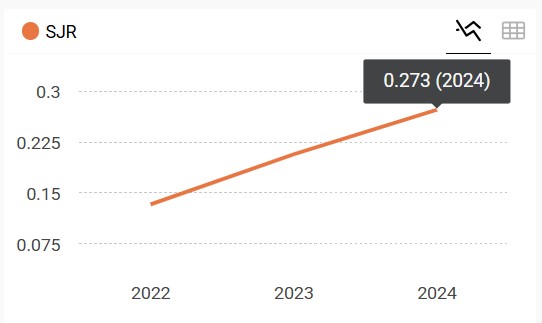Pengembangan dan Validasi Instrumen Pengukuran Efektivitas Tim di Usaha Mikro Kecil dan Menengah (UMKM)
DOI:
https://doi.org/10.21580/pjpp.v3i2.3014Keywords:
Confirmatory Factor Analysis (CFA), Exploratory Factor Analysis (EFA), team effectivenessAbstract
In general, research on the development of teamwork-measuring instruments is associated with the corporate context. While in Indonesia, research in the context of small and medium enterprises is equally important. This study aimed to develop and validate an instrument for measuring team effectiveness in small and medium enterprises (SMEs). The development of this measuring instrument used the theory developed by Cantu (2007) which consists of six aspects, namely teamwork, decision making, leadership support, trust and respect, recognition and appreciation, and customer focus. Research respondents were 404 employees from thirteen SMEs situated in Yogyakarta, who were selected by using purposive sampling technique. EFA analysis resulted in KMO = .821, indicating a reduction of the aspects from six to three: decision making, leadership support, and trust. While from the CFA analysis were obtained the values of CMIN=116,566, probability .057, CMIN/DF=1.240, GFI= .932, RMSEA = .034 so that it could be concluded that the model have been appropriate to measure the effectiveness of teamwork in small and medium enterprises.
Downloads
References
Azwar, S. (2013). Penyusunan skala psikologi. Yogyakarta: Pustaka Pelajar.
Bhudianto, W. (2015). Kepemimpinan dalam pengambilan keputusan. Transformasi, 27(1), 18–23. Retrieved from https://ejurnal.unisri.ac.id/index.php/Transformasi/article/view/910/762
Buzaglo, G., & Wheelan, S. A. (1999). Facilitating work team effectiveness: Case studies from Central America. Small Group Research, 30(1), 108–129. https://doi.org/10.1177/104649649903000106
Cantu, C. J. (2007). Evaluating team effectiveness: Examination of the TEAM Assessment Tool. North Texas: University of North Texas. Retrieved from https://digital.library.unt.edu/ ark:/67531/metadc3990/
Costello, A. B., & Osborne, J. W. (2005). Best practices in exploratory factor analysis : Four recommendations for getting the most from your analysis, 10(7), 1–10. Retrieved from https://www.semanticscholar.org/paper/Best-Practices-in-Exploratory-Factor-Analysis-%3A-for-Costello-Osborne/7ce6c453c20dae3bff4d792fbd1dcfd252fc7fc2
Cummings, T. G., & Worley, C. G. (2008). Organization development & change. Mason, Ohio, USA: South-Western - Cengage Learning.
Ghozali, I. (2016). Analisis multivariate program IBM SPSS 19. Semarang: Badan Penerbit Universitas Diponegoro.
Ghozali, I. (2017). Model persamaan struktural konsep dan aplikasi dengan Program AMOS 24 (update Bayesian SEM). Semarang: Badan Penerbit Universitas Diponegoro.
Hakanen, M., Häkkinen, M., & Soudunsaari, A. (2015). Trust in building high-performing teams – conceptual approach. EJBO: Electronic Journal of Business Ethics and Organization Studies, 20(2), 343–353. https://doi.org/10.1897/08-563.1
Hexmoor, H., & Beavers, G. (2002). Measuring team effectiveness. In Proceedings of 20th IASTED International Multiconference: (Vol. 74, pp. 338–343). Innsbruck, Austria: IASTED. https://doi.org/10.1177/109634808901300334
Mohanty, A., & Mohanty, S. (2018). The impact of communication and group dynamics on teamwork effectiveness: The case of service sector organisations. Academy of Strategic Management Journal, 17(4), 1–14.
Northouse, P. G. (2013). Kepemimpinan: Teori dan praktik (6th ed.). Jakarta: Indeks Gramedia.
Pallant, J. (2010). SPSS survival manual: A step by step guide to data analysis using the SPSS program. Australia: Allen & Unwin Book Publishers.
Pratiwi, W. K., & Nugrohoseno, D. (2014). Pengaruh kepribadian terhadap kerjasama tim dan dampaknya terhadap kinerja karyawan. Bisma (Bisnis dan Manajemen), 7(1), 63–72. https://doi.org/10.26740/bisma.v7n1.p63-72
Priyatno, D. (2010). Paham analisa statistik data dengan SPSS Plus: Tata cara dan tips menyusun skripsi dalam waktu singkat. Jakarta: Elex Media Komputindo.
Rini, W. A. (2006). Kepemimpinan yang membangun tim. Modernisasi, 2(2), 66–75.
Robbins, S. P., & Judge, T. A. (2015). Perilaku organisasi. (R. Saraswati, Terj.) (16th ed.). Jakarta: Salemba Empat.
Solimun, M. S. (2002). Structural Equation Modelling (SEM) Lisrel dan Amos. Malang: Fakultas MIPA Universitas Brawijaya.
Sudirman, F. (2013). Pemberian motivasi dalam upaya meningkatkan efektifitas kerja pegawai pada Kantor Kecamatan Kuaro Kabupaten Paser. E-Journal Ilmu Pemerintahan, 1(1), 46–56. Retrieved from http://ejournal.ip.fisip-unmul.ac.id/site/wp-content/uploads/2013/02/ journal dampak eksos %2802-12-13-01-34-45%29.pdf
Usman, H., & Sobari, N. (2013). Aplikasi teknik multivariate untuk riset pemasaran. Jakarta: Raja Grafindo Persada.
van Roosmalen, T. M. (2012). The development of a questionnaire on the subjective experience of teamwork, based on Salas, Sims and Burke’s “the big five of teamwork” and Hackman’s understanding of team effectiveness. Trondheim: Norges Teknisk Naturvitenskapelige Universitet. Retrieved from https://brage.bibsys.no/xmlui/handle/11250/270920
Waluyo, M. (2016). Mudah cepat tepat penggunaan tools Amos dalam aplikasi (SEM). Surabaya: UPN Veteran Jawa Timur.
Widarjono, A. (2010). Analisis statistika multivariat terapan. Yogyakarta: UPP STIM YKPN.
Widodo, P. B. (2006). Reliabilitas dan validitas konstruk skala konsep diri untuk mahasiswa Indonesia. Jurnal Psikologi, 3(1), 1–9. https://doi.org/10.14710/JPU.3.1.1 - 9
Downloads
Published
How to Cite
Issue
Section
License
The copyright of the accepted article shall be assigned to the publisher of the journal. The intended copyright includes the right to publish the article in various forms (including reprints). The journal maintains the publishing rights to published articles.
In line with the license, authors and any users (readers and other researchers) are allowed to share and adapt the material only for non-commercial purposes. In addition, the material must be given appropriate credit, provided with a link to the license, and indicated if changes were made. If authors remix, transform, or build upon the material, authors must distribute their contributions under the same license as the original.




